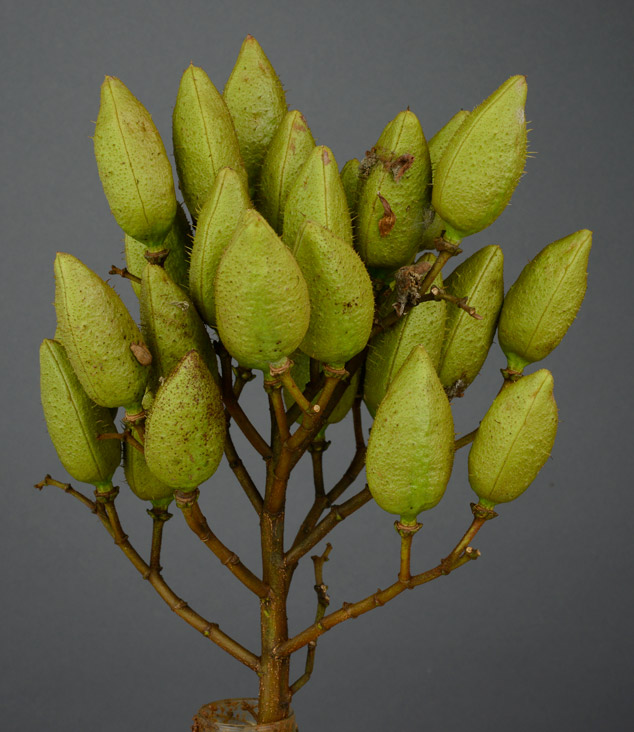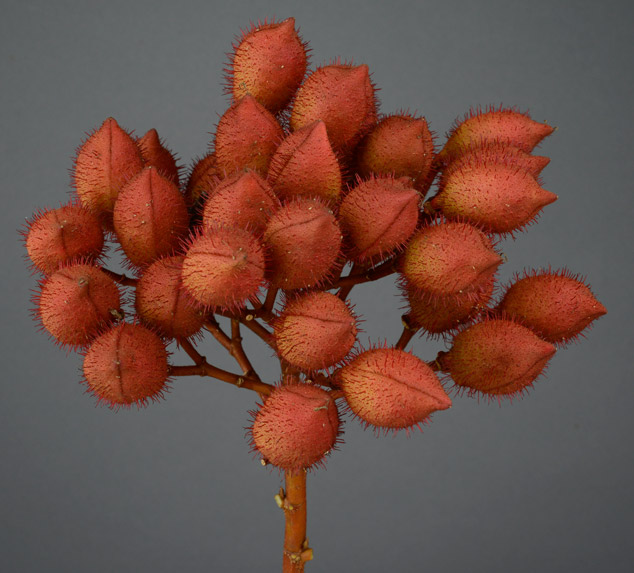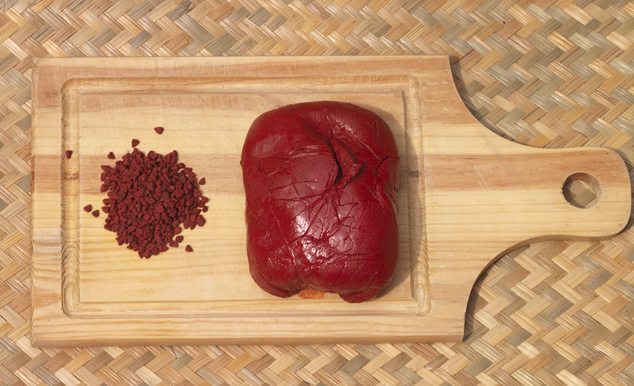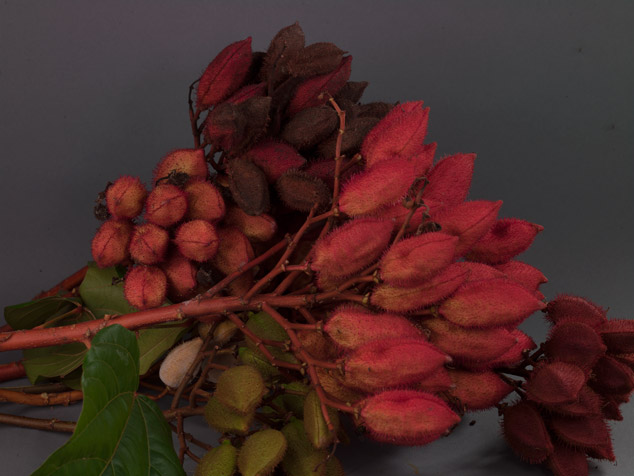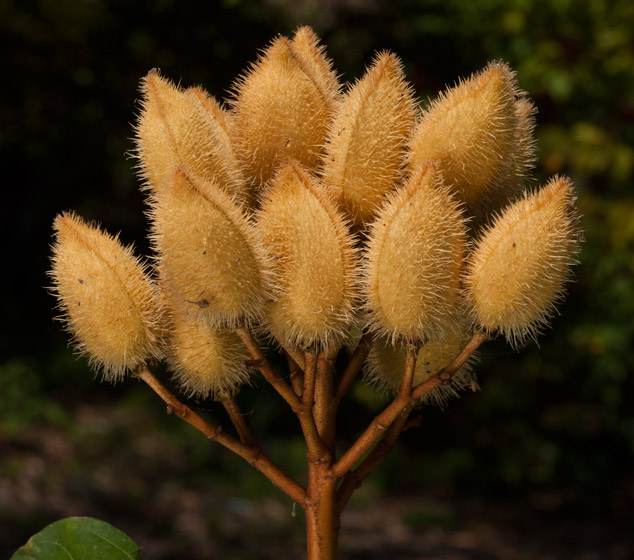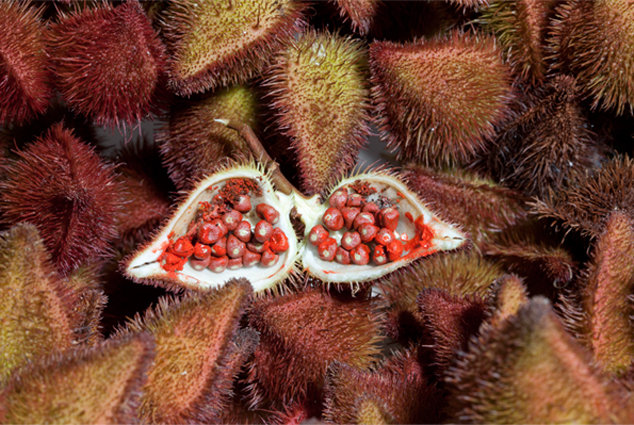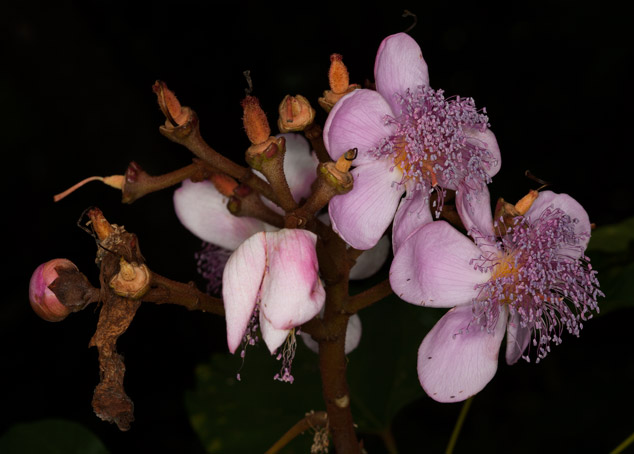What is achiote?
Achiote, Bixa orellana, annatto, is a major cash-crop of the Maya for the last several thousand years. When I was working in the Archivo General de las Indias, Seville, Spain, in 1971, I kept finding Spanish descriptions of all the achiote they noticed in the Verapaz region of Guatemala.
Where to find achiote, Bixa orellana?
Alta Verapaz is the main area where I see it in Guatemala, but also in Peten. For recipes achiote is best known for Yucatan, Mexico.
I see one kind of achiote along the highway from Coban, Alta Verapaz to Peten; and another slightly different kind of achiote plant in the area of Raxruha, also Alta Verapaz.
There probably are commercial plantations, but I mainly see it in gardens around the houses of the local Maya-speaking people.
The time of flowering and maturity of the achiote varies according to latitude and temperature area, being earlier in warm regions. In some regions, blooms during the months July and August, maturing from November to January.
Harvesting begins at 20 months it is scarce; commercial production it is obtained past 3 years.
Achiote (Bixa orellana) shrub with fruits, Photo FLAAR Archive
Achiote (Bixa orellana) fruits, Photo FLAAR Archive
Dye Removal
The separation of the waxy substance from the seeds is done in two ways: first, by putting enough seeds in boiling water for 6 hours or less, accelerates this detachment stirring with a spoon or piece of wood until the seeds are white, strained and the liquid obtained from the subject-bath to evaporate the excess water remaining in the bottom of the container waste or substance that will bind to each other by the consistency that has given the operator. After this operation is molded product of the more convenient and more acceptable to the consumer.
The second way is that according to the amount of seed is placed in a container water is added 1 / 2 or 3 / 4 of total volume, is I stirred vigorously until the dye layer to detach from the seed, then the liquid passes through a fine sieve, the liquid is evaporated to leave extracted dye consistency paste capable of being molded. Once dry, the dye is ready for market.
Achiote (Bixa orellana) from seed to paste the process of dye removal, Photo FLAAR Archive
Achiote Varieties
- Red Achiote
- Plants with white flowers and seeds black or vermilion.
- Increased performance, high dye; uniform ripening, greater hardiness and rapid growth.
- Yellow achiote
- Plant pink flowers, bright red seeds yellow. Have lower performance, have good content but are less rustic coloring.
- Achiote black or purple
- The stem, leaves and fruits are darker than the previous agrotipos, and contain a low percentage of coloring matter.
Diferent stages of achiote as fruit, seed and dye, Photo FLAAR Archive
Yellow achiote variety, Photo FLAAR Archive
We still need to find achiote when it is flowering:
I have not yet been in front of an annatto tree or bush when it was in full flowering (or if I was, I was so busy photographing the bright red seed pods that I neglected the pretty flowers). So we need to find and photograph the attractive flowers. I am always so keen to photograph the colorant, that I have neglected to photograph the trees or bushes when they have only flowers and no seeds!
Achiote seeds, Photo FLAAR Archive
The few photos of achiote flowers that we could found in the wild, Photo FLAAR Archive
Thesis or dissertation potential for Achiote, Bixa orellana
For an undergraduate thesis, achiote could keep you busy if you search all the ethnohistorical sources and get a veritable map of in which villages it was spotted as the Spanish invaded each part of the Maya world.
One thing you quickly notice about plants and the Maya is that there are two kinds of areas for each plant:
- the natural habitat where the plant is healthy and does or could grow wild.
- And the other habitats where the plant has been transported as a commercial or decorative plant.
This was already happening with achiote over two thousand years ago.
For such a thesis, questions about achiote could include, to what degree is this used in cacao drink as color and to what degree as a flavoring?
And would you drink cacao only with achiote? Or with achiote as coloring and chile for flavor? It is hard to fathom that the Aztec or Maya added the entire list of spices into their cacao all at once. Each spice would have been “lost” with so many other spices on top of it.
And when chemists test ancient Maya cacao vessels for cacao, perhaps they should also check for annetto while they have the samples.
It would also help to have complete tabulations of all major indigenous menus for which achiote is used. And which meals were developed during the Spanish period. For example, Mole Poblano is not necessarily pre-Columbian (just an example). Many “local foods” are as much Spanish or Spanish-Maya mixture. We should be looking for how the pre-Hispanic Maya used achiote.
And what about trade routes? Where could achiote not be raised easily? Due to altitude, cold weather, lack of humidity?
Was achiote traded into the areas where it could not be raised? This would suggest there was “international” demand for achiote even two thousand years ago.
Last update March 11, 2013
Previously updated August 11, 2011, First posted July 07, 2011.


